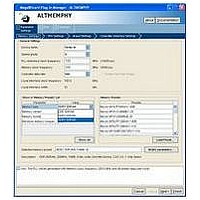IPR-HPMCII Altera, IPR-HPMCII Datasheet - Page 63

IPR-HPMCII
Manufacturer Part Number
IPR-HPMCII
Description
IP CORE Renewal Of IP-HPMCII
Manufacturer
Altera
Datasheet
1.IP-HPMCII.pdf
(176 pages)
Specifications of IPR-HPMCII
Software Application
IP CORE, Memory Controllers, SDRAM
Supported Families
Arria II GX, HardCopy III, Stratix III, Stratix IV
Core Architecture
FPGA
Core Sub-architecture
Arria, HardCopy, Stratix
Rohs Compliant
NA
Lead Free Status / RoHS Status
na
- Current page: 63 of 176
- Download datasheet (4Mb)
Chapter 5: Functional Description—ALTMEMPHY
Block Description
December 2010 Altera Corporation
Address and Command Datapath
f
f
1
1
Step 7: Write Clock Path Setup
After the sequencer has the optimum settings for read capture and resynchronization
setup, the sequencer calibrates the write datapath by configuring the alignment
registers in the IOE and the DQ and DQS phase shift per DQS group. This step
ensures that the write data can be presented on the same clock cycle from controller,
but launched at the appropriate time for each DQS group to the DDR3 SDRAM
memory devices.
Step 8: Prepare for User Mode
In this step, the sequencer sends the calibrated write latency between command and
write data (the ctl_wlat signal) to the controller. The PHY then applies user mode
register settings and performs setup for periodic VT tracking.
Deskew is automatically enabled above 400.000 MHz.
VT Tracking
For information on VT tracking for DDR3 SDRAM with leveling, refer to
Tracking” on page
Mimic Path
For information on mimic path for DDR3 SDRAM with leveling, refer to
Path” on page
This topic discusses the address and command datapath.
Arria II GX Devices
The address and command datapath is responsible for taking the address and
command outputs from the controller and converting them from half-rate clock to
full-rate clock. Two types of addressing are possible:
■
■
Refer to
the rest of the clocks.
1T (full rate)—the duration of the address and command is a single memory clock
cycle (mem_clk_2x,
full-rate designs or mem_cs_n, mem_cke, and mem_odt signals in half-rate designs.
2T (half rate)—the duration of the address and command is two memory clock
cycles. For half-rate designs, the ALTMEMPHY megafunction supports only a
burst size of four, which means the burst size on the local interface is always set to
1. The size of the data is 4n-bits wide on the local side and is n-bits wide on the
memory side. To transfer all the 4n-bits at the double data rate, two memory-clock
cycles are required. The new address and command can be issued to memory
every two clock cycles. This scheme applies to all address and command signals,
except for mem_cs_n, mem_cke, and mem_odt signals in half-rate mode.
Table 5–1 on page 5–14
5–6.
5–5.
Figure
5–6). This applies to all address and command signals in
to see the frequency relationship of mem_clk_2x with
Section II. DDR3 SDRAM Controller with ALTMEMPHY IP User Guide
External Memory Interface Handbook Volume 3
“Mimic
“VT
5–11
Related parts for IPR-HPMCII
Image
Part Number
Description
Manufacturer
Datasheet
Request
R

Part Number:
Description:
IP NIOS II MEGACORE RENEW
Manufacturer:
Altera
Datasheet:

Part Number:
Description:
IP CORE Renewal Of IP-XAUIPCS
Manufacturer:
Altera
Datasheet:

Part Number:
Description:
IP CORE Renewal Of IP-10GETHERNET
Manufacturer:
Altera
Datasheet:

Part Number:
Description:
IP CORE Renewal Of IP-ASI
Manufacturer:
Altera
Datasheet:

Part Number:
Description:
IP CORE Renewal Of IP-CIC
Manufacturer:
Altera
Datasheet:

Part Number:
Description:
IP CORE Renewal Of IP-CRC
Manufacturer:
Altera
Datasheet:

Part Number:
Description:
IP CORE Renewal Of IP-ED8B10B
Manufacturer:
Altera
Datasheet:

Part Number:
Description:
CPLD, EP610 Family, ECMOS Process, 300 Gates, 16 Macro Cells, 16 Reg., 16 User I/Os, 5V Supply, 35 Speed Grade, 24DIP
Manufacturer:
Altera Corporation
Datasheet:

Part Number:
Description:
CPLD, EP610 Family, ECMOS Process, 300 Gates, 16 Macro Cells, 16 Reg., 16 User I/Os, 5V Supply, 15 Speed Grade, 24DIP
Manufacturer:
Altera Corporation
Datasheet:

Part Number:
Description:
Manufacturer:
Altera Corporation
Datasheet:










